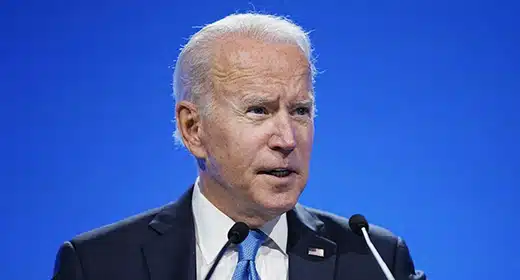by Will Sullivan: Biden announced plans for tackling the powerful greenhouse gas, which could go into effect by the end of next year.
 The United States is taking aim at methane emissions with a set of proposed rules that President Joe Biden announced last week at COP27, the United Nations Climate Change Conference. The new initiatives, suggested by the Environmental Protection Agency (EPA), expand on regulations the agency proposed a year ago and could take effect as soon as 2023, according to Grist’s Emily Pontecorvo.
The United States is taking aim at methane emissions with a set of proposed rules that President Joe Biden announced last week at COP27, the United Nations Climate Change Conference. The new initiatives, suggested by the Environmental Protection Agency (EPA), expand on regulations the agency proposed a year ago and could take effect as soon as 2023, according to Grist’s Emily Pontecorvo.
The new rules would prevent 36 million tons of methane emissions by the end of the decade—the same impact as turning off all the country’s coal power plants for a year, writes Grist.
At the conference, Biden vowed that the U.S. will meet its goal of reducing methane emissions by 30 percent from 2020 levels by 2030, due in part to these new rules, if enacted, report Matthew Daly and Seth Borenstein of the Associated Press (AP).
The EPA has “taken an important step forward by issuing a robust standard for methane emissions from oil and gas operations,” Rachel Cleetus, lead economist for the nonprofit science advocacy organization Union of Concerned Scientists, tells the Wall Street Journal’s Eric Niiler and Chao Deng.
Methane is around 80 times more powerful than carbon dioxide at warming the planet during its first 20 years in the atmosphere. And atmospheric methane concentrations increased by a record amount last year. But since the gas breaks down after about a decade on average, reducing these emissions can quickly have an impact on limiting climate change, writes Grist.
According to the International Energy Agency, methane has caused 30 percent of global temperature increases since the Industrial Revolution, and the oil and gas sector is responsible for 40 percent of methane emissions worldwide, Mike Soraghan wrote for E&E News in February.
With the new proposal, the EPA is targeting these emissions from oil and gas. Currently, the agency regulates methane leaks at the country’s 300,000 largest well sites, but one of the new rules will expand this oversight to all one million well sites, according to Reuters’ Valerie Volcovici. Companies will be required to find and fix leaks, even at small wells. Studies have found that while smaller wells produce only 6 percent of the country’s oil and gas, they contribute up to half the methane emissions from wells, writes the AP.
The agency also plans to crack down on flaring, a practice by gas producers that burns excess methane from wells. Gas producers would have to capture the methane instead, unless they can demonstrate that it wouldn’t be possible or safe, according to Grist.
“While we are disappointed EPA did not propose an outright ban on oil and gas industry flaring, we are nonetheless encouraged by the draft rule’s incisive measures to tackle leak detection and repair from all sources, including low-producing and abandoned wells,” Melissa Hornbein, a senior attorney at the Western Environmental Law Center, tells Grist.
The final rule would use government data and remote technology to create a program for detecting major leaks and alerting emitters so they can address them, writes Reuters.
The proposed regulations come after the Biden administration passed the Inflation Reduction Act earlier this year, which allows large emitters to be fined per ton of methane released, according to Inside Climate News’ Phil McKenna.
The EPA plans to finalize the rules by the end of next year.
As the COP27 climate conference draws to a close, Nigeria and Canada have also said they plan to reduce methane emissions, according to the Wall Street Journal. Low-emitting countries that have faced natural disasters exacerbated by climate change are calling for the bigger emitters to contribute to a “loss and damage” fund. Nations including Scotland, Denmark, Germany and Austria have pledged funds. But so far, the United States has not.
Experts have also raised concerns that some countries want to backtrack from the goal of keeping global temperatures from rising more than 1.5 degrees Celsius above pre-industrial levels. With negotiations dragging on, the countries are left with several big decisions to make, even on the last day of the summit.









































